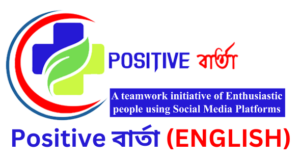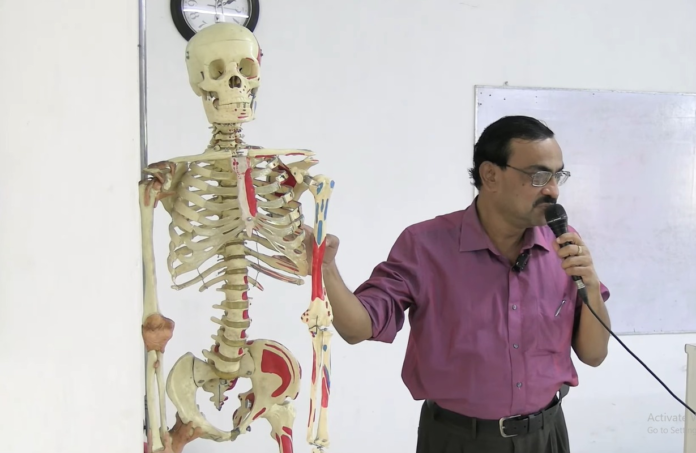Lecture on ‘Anatomy’: Santiniketan Medical College & Hospital recently hosted a highly informative and engaging lecture on Human Anatomy, presented by Dr. Srijit Narayan Chaudhuri, a renowned expert in the field of anatomical sciences. The session, aimed at medical students and faculty members, focused on the intricate details of human body structures, their functions, and the underlying principles that govern their interactions. Dr. Chaudhuri’s approach to teaching anatomy is both comprehensive and accessible, ensuring that students gain a deep understanding of the subject.
Dr. Srijit Narayan Chaudhuri: A Profile of Excellence
Dr. Srijit Narayan Chaudhuri is a distinguished anatomist with years of experience in both clinical and academic settings. Known for his exceptional teaching skills and vast knowledge of human anatomy, Dr. Chaudhuri has been a significant influence in the field of medical education. He holds an impressive record of training countless medical students and professionals, imparting not only theoretical knowledge but also practical skills essential for a successful medical career.
His teaching philosophy revolves around simplifying complex anatomical concepts and making them relatable to real-life medical scenarios. Dr. Chaudhuri is particularly known for his ability to connect structure with function, illustrating how anatomical features are intricately linked to physiological processes. His engaging teaching style has earned him the admiration of students and peers alike.
The Lecture: An Overview of Human Anatomy
The lecture presented by Dr. Chaudhuri at Santiniketan Medical College & Hospital was centered around understanding the fundamental aspects of human anatomy—an essential subject for every aspiring medical professional. The session covered a wide range of topics, including the structural organization of the human body, the importance of various organ systems, and the interrelation between different anatomical features.
Dr. Chaudhuri began the lecture by emphasizing the importance of anatomy in the medical field, stating that a deep understanding of the human body’s structure is the foundation of all medical practice. According to him, a physician’s ability to diagnose and treat conditions relies heavily on knowledge of the body’s internal and external structures.
Key Highlights of the Lecture
- Understanding Body Structure and OrganizationDr. Chaudhuri started the session by explaining the hierarchical organization of the human body, beginning with cells, tissues, and organs, and advancing to complex organ systems. He emphasized how the body is a remarkable collection of systems working in harmony. “Understanding the basic building blocks of the body is crucial for a medical professional, as it provides the foundation for understanding the function of organs and tissues,” Dr. Chaudhuri stated.He introduced students to the concept of anatomical planes, axes, and terms of direction, ensuring that they understood how to describe the location of structures in a standardized manner. Dr. Chaudhuri explained the concept of anatomical position and how it serves as a reference point for describing body parts, ensuring consistency in medical communication.
- The Importance of Organ SystemsA significant portion of the lecture was dedicated to the major organ systems, including the cardiovascular, respiratory, nervous, digestive, and musculoskeletal systems. Dr. Chaudhuri highlighted the unique structural features of each system and discussed how their specific structures are intricately designed to fulfill their functions effectively.For example, when discussing the cardiovascular system, Dr. Chaudhuri illustrated how the heart’s anatomy, with its four chambers and valves, is perfectly suited to its function of pumping blood throughout the body. Similarly, he delved into the structure of the lungs and how the branching pattern of bronchi and alveoli is designed to optimize gas exchange. “Anatomy is not just about knowing where things are; it’s about understanding how the design of the body allows it to function in the most efficient way,” he explained.
- The Nervous System: A Complex NetworkThe lecture also provided an in-depth exploration of the nervous system, one of the most complex systems in the human body. Dr. Chaudhuri discussed the structure of the brain, spinal cord, and peripheral nerves, explaining how the body communicates through electrical signals. He elaborated on the importance of the central nervous system in regulating bodily functions, and how the brain’s anatomical regions correlate with specific cognitive and motor functions.“The nervous system is the body’s communication network,” Dr. Chaudhuri remarked. “Every movement, thought, and sensation is the result of coordinated electrical impulses traveling through this intricate system. A clear understanding of its anatomy is vital for diagnosing neurological disorders.”
- Integration of Anatomy and PhysiologyOne of the most impactful aspects of Dr. Chaudhuri’s lecture was his emphasis on the integration of anatomy and physiology. He demonstrated how anatomical structures directly correlate with physiological functions. For example, the structure of the kidney’s nephrons enables them to filter blood and produce urine, while the architecture of the digestive system facilitates the breakdown and absorption of food.”Anatomy and physiology are inseparable. You cannot understand the function of an organ without first understanding its structure, and vice versa. This is why we must study both in parallel,” he said.
- Practical Application in Clinical MedicineDr. Chaudhuri emphasized that anatomical knowledge is not only important for understanding normal body functions but is also essential for diagnosing diseases and performing surgical procedures. He highlighted how a deep understanding of anatomy allows medical professionals to identify abnormalities, plan treatments, and perform precise procedures.“Anatomical knowledge helps doctors approach their patients with a clear mental map of the body. Whether it’s identifying the site of injury, performing surgery, or even administering medications, a precise knowledge of anatomy is fundamental,” he added.
The Role of Dissection and Practical Learning
Dr. Chaudhuri also underscored the importance of hands-on learning through dissection and practical exercises. He encouraged students to actively engage with cadavers in the dissection lab, as this experience provides an invaluable understanding of the body’s structures. “The true understanding of anatomy comes from not just reading textbooks but physically interacting with the human body, observing its tissues and organs firsthand,” Dr. Chaudhuri emphasized.
The dissection practice, he explained, helps students visualize and internalize anatomical concepts, making it easier for them to relate theory to real-world medical applications.
Interactive Q&A Session
At the end of the lecture, Dr. Chaudhuri opened the floor to questions, allowing students to clarify doubts and discuss anatomical concepts further. The interactive Q&A session was an essential component of the lecture, providing students with the opportunity to engage in deeper discussions and strengthen their understanding of the material. Dr. Chaudhuri patiently addressed each question, offering detailed explanations and further examples to solidify the students’ grasp of anatomy.
Conclusion: Shaping Future Medical Professionals
Dr. Srijit Narayan Chaudhuri’s lecture on anatomy at Santiniketan Medical College & Hospital proved to be an enriching experience for the students. The session not only enhanced their theoretical knowledge of human body structures but also highlighted the critical importance of anatomy in clinical practice. By integrating detailed anatomical knowledge with practical applications, Dr. Chaudhuri provided students with the tools they need to excel in their medical careers.
As the lecture concluded, students left the session with a greater appreciation for the complexities of the human body and the critical role anatomy plays in medicine. Dr. Chaudhuri’s session was a reminder that the study of anatomy is not just about memorizing facts; it’s about understanding how the human body functions as a highly integrated and efficient system. This knowledge will undoubtedly shape the next generation of healthcare professionals who are equipped to provide optimal care to their patients.








[…] Read More: In-Depth Lecture on Anatomy by Dr. Srijit Narayan Chaudhuri at Santiniketan Medical College & Ho… […]